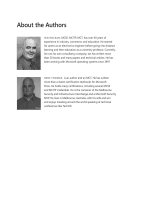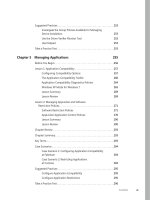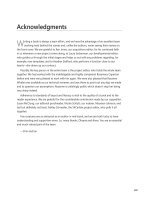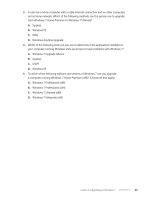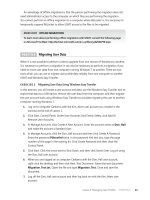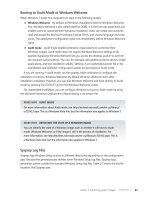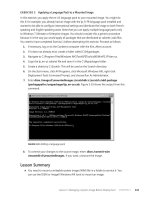Configuring Windows 7 (Training Kit) - Part 17 doc
Bạn đang xem bản rút gọn của tài liệu. Xem và tải ngay bản đầy đủ của tài liệu tại đây (268.96 KB, 10 trang )
Lesson 1: Managing a System Image Before Deployment CHAPTER 3 133
If your image needs to include a keyboard driver for Japanese or Korean keyboards, you
can use the /set-layereddriver option. This option takes an argument of 1 through 6 as follows:
1. PC/AT Enhanced Keyboard (101/102-Key)
2. Korean PC/AT 101-Key Compatible Keyboard/MS Natural Keyboard (Type 1)
3. Korean PC/AT 101-Key Compatible Keyboard/MS Natural Keyboard (Type 2)
4. Korean PC/AT 101-Key Compatible Keyboard/MS Natural Keyboard (Type 3)
5. Korean Keyboard (103/106 Key)
6. Japanese Keyboard (106/109 Key)
You can use the /set-allintl option to set the user interface (UI) language, system locale,
user locale, and input locale to the same value, for example, en-US. If you use the /set-allintl
option with any of the options that specify the individual language or locales, the individual
settings take precedence.
You can also use the /set-skuintldefaults option to set an image’s default system UI language,
language for non-Unicode programs, standards and formats language, input locale, keyboard
layout, and time zone values to the Windows 7 default value specified by a language name
argument, such as en-US. Note that the /set-skuintldefaults option does not change the
keyboard driver for Japanese and Korean keyboards. You use the /set-layereddriver option to
specify this.
You can use the /set-timezone option to specify the default time zone. If you use this
option, DISM verifies that the specified time-zone string is valid for the image. The name of
the time zone must exactly match the name of the time zone settings in the registry in the
HKLM\SOFTWARE\Microsoft\Windows NT\CurrentVersion\TimeZones\ registry key. If you add
a custom time zone to your computer, you can specify that custom time-zone string.
note THE Tzutil COMMAND-LINE TOOL
On a computer running Windows 7, you can use the Tzutil command-line tool to list the
time zone for that computer. The Tzutil tool is installed by default on Windows 7 and is not
part of the Windows AIK.
Managing Windows Editions
Windows 7 edition packages for each potential target edition are staged within a Windows 7
Install.wim image on Windows 7 installation media. This is referred to as an edition-family
image. Because the target editions are staged, you can service a single mounted image and
apply the updates as appropriate to each edition in the image. This reduces the number of
images you have to manage. However, it could increase the factory time or user time spent in
the specialize configuration pass.
You can use the Windows edition-servicing commands to change one edition of Windows 7
to a higher edition within the same edition family. When you upgrade an offline image, you do
1 3 4 CHAPTER 3 Deploying System Images
not require a product key. If you change an online image to a higher edition, you can add the
product key using one of the following methods:
n
Enter the product key during the out-of-box experience (OOBE) pass.
n
Use an unattended answer file to enter the product key during the specialize
configuration pass.
n
Use DISM and the Windows edition-servicing command-line option /set-productkey
after you configure the edition offline.
You can use the following edition-servicing options on an offline image to list editions or
to change a Windows image to a higher edition:
dism /image:path_to_ image_directory [/get-currentedition | /get-targeteditions |
/set-edition | /set-productkey]
On a running Windows 7 operating system, the following edition-servicing options are
available:
dism /online [/get-currentedition | /get-targeteditions]
Because this book is written for the Windows 7 installation image and product code on
the installation media supplied, you will not be able to upgrade the mounted image you
generated and placed on a bootable VHD and then subsequently mounted. The following
commands entered on the online image or the installed image that you mount in the practice
session exercises later in this lesson identify the online and mounted image Windows 7
editions:
dism /online /get-currentedition
dism /image:c:\mountedimages / get-currentedition
Similarly you cannot upgrade your current edition to a target edition. As shown in
Figure 3-13, the following command should tell you just that:
dism /online /get-targeteditions
FIGURE 3-13 No target editions are available.
Lesson 1: Managing a System Image Before Deployment CHAPTER 3 135
If a target edition is available, you can use the /set-edition option without the /productkey
option to change an offline Windows image to a higher edition. Use /get-targeteditions to
discover the edition ID. To change a running operating system to a higher edition, you can
use the /set-edition option with the /productkey option, as in the following command:
dism /online /set-edition:Ultimate /productkey:12345-67890-12345-67890-12345
Servicing Windows PE Images
You can mount a Windows PE image and add or remove packages, drivers, and language
packs in the same way as you would for any other Windows 7 image. DISM also provides
options specific to a Windows PE image. You can use these options to prepare the Windows
PE environment, enable profiling, list packages, and prepare the Windows PE image for
deployment.
For example, if you use DISM or ImageX to mount a Windows PE image in the folder
C:\MountedPEImage, the options specific to Windows PE are as follows:
dism /image:c:\mountedpeimage [/get-pesettings | /get-profiling | /get-scratchspace |
/get-targetpath | /set-scratchspace: | /set-targetpath : | /enable-profiling |
/disable-profiling | /apply-profiles path_to_myprofile.txt]
note DISM WINDOWS PE OPTIONS APPLY ONLY TO OFFLINE-MOUNTED IMAGES
You cannot use DISM Windows PE options to manage an online, running version of
Windows PE. You must specify a mounted Windows PE image using the /image: path_to_
image_directory option.
You can obtain a list of PE settings in a mounted Windows PE image by entering
a command similar to the following:
dism /image:c:\mountedpeimage /get-pesettings
You can discover whether the Windows PE profiling tool is enabled or disabled by entering
a command similar to the following:
dism /image:c:\mountedpeimage /get-profiling
If you need to find out the amount of writeable space available on a Windows PE system
volume when booted in RAMdisk mode, known as the Windows PE system volume scratch
space, you can enter a command similar to the following:
dism /image:c:\mountedpeimage /get-scratchspace
Similarly, if you need to know the path to the root of the Windows PE image at boot time,
known as the target path, you can enter a command similar to the following:
dism /image:c:\mountedpeimage /get-targetpath
1 3 6 CHAPTER 3 Deploying System Images
You can set the scratch space and the target path by using commands similar to the
following:
dism /image:c:\mountedpeimage /set-scratchspace:256
dism /image:c:\mountedpeimage /set-targetpath:D:\WinPEboot
Scratch space is specified in megabytes. Valid values are 32, 64, 128, 256, and 512. In hard
disk boot scenarios, the target path defines the location of the Windows PE image on the
disk. The path must be at least 3 characters and no longer than 32 characters. It must have
a volume designation (C:\, D:\, and so on) and it must not contain any blank spaces.
File logging (or profiling) lets you create your own profiles in Windows PE 3.0 or later.
By default, profiling is disabled. You can enable it, or disable it if previously enabled, by
entering commands similar to the following:
dism /image:c:\mountedpeimage /enable-profiling
dism /image:c:\mountedpeimage /disable-profiling
When you create one or more profiles, each is stored in its own folder and identified in
the file Profile.txt. You can remove any files from a Windows PE image that are not part of the
custom profiles and check the custom profile against the core profile to ensure that custom
application files and boot-critical files are not deleted, by entering a command similar to the
following:
dism /image:c:\mountedpeimage /apply-profiles:c:\peprofiles\profile01\profile.txt,
c:\peprofiles\profile02\profile.txt
The paths to one or more profile.txt files are included in the command as a comma-
separated list.
Quick Check
1. You want to obtain a list of PE settings in a mounted Windows PE image in the
folder C:\Mypeimage. What command do you enter in the elevated Deployment
Tools command prompt?
2. You need to determine the amount of Windows PE system volume scratch space
available on a Windows PE system volume in a mounted Windows PE image in
the folder C:\Mypeimage when booted in RAMdisk mode. What command do
you enter in the elevated Deployment Tools command prompt?
Quick Check Answers
1. dism /image:c:\mypeimage /get-pesettings
2. dism /image:c:\ mypeimage /get-targetpath
Lesson 1: Managing a System Image Before Deployment CHAPTER 3 137
Unattended Servicing Command-Line Options
You can use DISM to apply an Unattend.xml answer file to an image. Typically, you would use
this feature when you are installing multiple packages to the image. As stated previously in
this lesson, some packages require other packages to be installed first. Microsoft recommends
that the best way of ensuring the correct installation order is to use an answer file. If you use
DISM to apply an Unattend.xml answer file to an image, the unattended settings in the offline
Servicing configuration pass (previously described in Chapter 2) are applied to the Windows
image.
The following servicing options are available to apply an Unattend.xml answer file to
a offline Windows image:
dism /image:path_to_ image_directory /apply-unattend:path_to_unattend.xml
The following command applies an Unattend.xml answer file to a running operating
s y s t e m :
dism /online /apply-unattend:path_to_unattend.xml
For example, if the Unattend.xml file is located in C:\Windows\Panther, you can apply it to
an offline-mounted image in C:\Mountedimages by entering the following command:
dism /image:c:\mountedimages /apply-unattend:c:\windows\panther\unattend.xml
Figure 3-14 shows the output from this command. It tells you the answer file has been
applied but gives no additional information.
FIGURE 3-14 Applying an answer file to an offline-mounted image
Using Answer Files with Windows Images
The ability to associate an Unattend.xml answer file to an image provides a powerful tool to
implement and configure image deployment, and to determine actions that can be taken if
deployment fails or after deployment succeeds.
1 3 8 CHAPTER 3 Deploying System Images
As discussed in Chapter 2, an answer file is an Extensible Markup Language (XML) file
that contains setting definitions and values to use during Windows Setup. You specify Setup
options in an answer file, including how to partition disks, the location of the Windows image
to install, the product key to apply, and other custom Windows Setup settings. You can
also specify values such as names of user accounts, display settings, and Windows Internet
Explorer favorites. The answer file is typically called Autounattend.xml and is created using
Windows System Image Manager (Windows SIM), as described in Chapter 2. If you want to
add an additional answer file to install applications or specify the order in which packages
are installed, you would typically use the file name Unattend.xml. When Windows SIM opens
a Windows image file or catalog file, all of the configurable features and packages inside that
image are displayed in the Windows Image pane. You can then add features and settings to
the answer file.
Quick Check
n
Your offline-mounted WIMimage file is in C:\Images\Mounted. An unattend
answer file that you want to associate with this image has the file path
C:\Answerfiles\Unattend\Unattend.hml. What command associates the answer
file with the image?
Quick Check Answer
n
dism /image:c:\images\mounted /apply-unattend:c:\answerfiles\unattend\
unattend.hml
Chapter 2 described how Windows SIM displays the properties and settings of a selected
feature or package in its Properties pane. You can manage the feature settings for each
configuration pass in this Properties pane. In the case of packages, editable Windows feature
selections are displayed. Settings that are not available for each feature or package appear
dimmed. Settings that have been edited appear in bold. Feature settings let you configure the
aspects of each feature in a Windows 7 installation during unattended setup. For example, the
Internet Explorer feature setting Home_Page can be configured to open to a particular URL
by configuring the default value of the setting.
Feature properties are nonconfigurable attributes of the feature. Feature properties display
differently when the feature is added to the currently open answer file. Feature IDs uniquely
identify the feature of the operating system to which the settings belong. The ID contains the
name, version, architecture, and so on for the feature selected in the Windows Image pane or
Answer File pane. For example, the Language ID specifies the language code and the Name ID
specifies the name of the feature or package. Package properties are nonconfigurable package
attributes. For example, the ID Attribute package property specifies the identifier for the
package in the following format: ProcessorArchitecture_Version_Language_PublicKeyToken_
VersionScope.
Lesson 1: Managing a System Image Before Deployment CHAPTER 3 139
Package settings are configurable attributes of a package placed in the Answer File pane,
where you can edit them; for example, the Action package setting defines the action to be
performed on the package. Possible actions are Install, Configure, Remove, or Stage.
Settings are sometimes organized into groups called list items. List items specify one or
more values for a list item type. A list item type may include one or more feature settings.
For example, you can create multiple favorites links by using the Favorite Item setting for
Internet Explorer. Each list item must have a unique identifier, which is known as the key for
that specific list item. If you use Windows SIM to manage list items, this enables you to add or
delete a list item or modify its properties.
You can extend this concept to automate post-installation tasks. You can edit the answer file
with a text editor in addition to Windows SIM. For example, if you are accustomed to writing
batch files to automate application installation, you can add the same code to an answer file.
Windows SIM creates a binary catalog file that lists all the settings in a Windows image.
You can create code manually or use Windows SIM to create a distribution that contains
third-party drivers, applications, and Microsoft packages such as security bulletins. To create
a distribution share, you must first create a distribution-share folder manually or by using
Windows SIM. A distribution share is a shared Windows folder that contains the following
subfolders:
n
$OEM$ folders
n
Packages
n
Out-of-box drivers
n
LangPacks
Creating Answer Files
Microsoft recommends the use of Windows SIM to create unattend answer files, although
you can also edit and create such files with a text editor such as Microsoft Notepad. If you use
a manually authored answer file, you must validate the answer file in Windows SIM to verify
that the answer file works. Answer files from Windows XP, Windows Server 2008, or Windows
Vista do not work in Windows 7.
In general, it is best to expand to the lowest level of a feature and select only those
elements that you intend to set. If you want to accept a default value, there is no need to
include the element unless it is a required element. When creating answer files, you need to
understand what happens during each configuration pass. Chapter 2 described configuration
passes.
More Info CONFIGURATION PASSES
For more information about how configuration passes work, see />en-us/library/dd744341(WS.10).aspx.
1 4 0 CHAPTER 3 Deploying System Images
When adding data, such as additional drivers or applications, take care that you do
not overwrite Windows System files. Overwriting system files can corrupt your computer’s
operating system.
More Info ADDING APPLICATIONS, DRIVERS, PACKAGES, FILES, AND FOLDERS
For more information about adding applications, drivers, packages, files, and folders, see
/>Using Multiple Answer Files
You can use multiple second answer files (Unattend.xml) to create different custom images.
For example, you could create a generic answer file that is used for each of your systems and
then apply a second answer file during audit mode for changing disk configurations, drivers,
or applications. To do this, you would use the Sysprep command (described in Chapter 2) with
the /unattend:answerfile option. You can run this command manually during audit mode or
you can add a custom command.
More Info ADDING CUSTOM COMMANDS AND SCRIPTS
For more information about adding custom commands and scripts, see rosoft
.com/en-us/library/dd744393(WS.10).aspx.
Practice Mounting an Offline Image and Installing Language Packs
In this practice, you use both ImageX and DISM to mount an image. You also practice
unmounting an image. You then apply language packs to a mounted image.
exercise 1 Mounting, Unmounting, and Remounting an Image
In this exercise, you use the ImageX tool to mount the system image Myimage.wim that you
installed on the VHD to which you allocated drive letter W:. You mount the image in the
folder C:\Mountedimages. You then unmount the folder. Finally, you use DISM to mount
the image to the folder D:\Mountedimages. Note that it is not essential to create a different
folder to hold the second mounted image. However, if you do not, it is a good idea to delete
and re-create the original folder because DISM sometimes returns an error even though the
image has been unmounted from the folder. Proceed as follows:
1. Log on to the Canberra computer with the Kim_Akers account.
2. Create a folder called C:\MountedImages. If this folder already exists, ensure that it is
empty.
3. On the Start menu, right-click Computer and choose Manage. Select Disk
Management. If the W: disk does not appear in the Volume list, right-click Computer
Lesson 1: Managing a System Image Before Deployment CHAPTER 3 141
Management and choose Attach VHD. Navigate to the Myvhd.vhd file in the C:\VHDs
folder, as shown in Figure 3-15, and click OK. Drive W: should then appear. If necessary,
close the AutoPlay dialog box.
FIGURE 3-15 Attach the VHD if it does not appear in Computer Management.
4. On the Start menu, click All Programs, click Microsoft Windows AIK, right-click
Deployment Tools Command Prompt, and choose Run As Administrator.
5. In the Deployment Tools command prompt, enter the command: imagex /mountrw
w:\myimage.wim 1 c:\mountedimages. Figure 3-16 shows the output from this
command.
FIGURE 3-16 Using ImageX to mount a WIM image
1 4 2 CHAPTER 3 Deploying System Images
6. If you want, you can unmount the image and then use the DISM tool to mount it in
a different folder. To unmount the tool, enter the command: imagex /unmount
c:\mountedimages. Figure 3-17 shows the output from this command.
FIGURE 3-17 Unmounting an image
7. Create a folder called D:\MountedImages. If you do not have a second hard disk, you
can use the C:\MountedImages folder, but you might need to delete and re-create it if
DISM returns an error.
8. Mount the image with the DISM tool by entering the command: dism /mount-wim
/wimfile:w:\myimage.wim /index:1 /mountdir:d:\mymountedimages.
9. Test the image is mounted correctly by entering the command dism /get-mountedwiminfo.
The output from this command is shown in Figure 3-18. Note that the mounted image folder
is not the same as that shown in Figure 3-4 earlier in this lesson.
FIGURE 3-18 An image mounted in D:\Mountedimages
